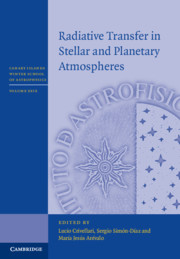Book contents
- Frontmatter
- Contents
- List of Contributors
- Preface
- Acknowledgements
- 1 The Physical Grounds of Radiative Transfer
- 2 Fundamental Physical Aspects of Radiative Transfer
- 3 Numerical Methods in Radiative Transfer
- 4 Stellar Atmosphere Codes
- 5 Radiative Transfer in the (Expanding) Atmospheres of Early-Type Stars, and Related Problems
- 6 Phenomenology and Physics of Late-Type Stars
- 7 Modelling the Atmospheres of Ultracool Dwarfs and Extrasolar Planets
3 - Numerical Methods in Radiative Transfer
Published online by Cambridge University Press: 24 December 2019
- Frontmatter
- Contents
- List of Contributors
- Preface
- Acknowledgements
- 1 The Physical Grounds of Radiative Transfer
- 2 Fundamental Physical Aspects of Radiative Transfer
- 3 Numerical Methods in Radiative Transfer
- 4 Stellar Atmosphere Codes
- 5 Radiative Transfer in the (Expanding) Atmospheres of Early-Type Stars, and Related Problems
- 6 Phenomenology and Physics of Late-Type Stars
- 7 Modelling the Atmospheres of Ultracool Dwarfs and Extrasolar Planets
Summary
This chapter considers a selection of numerical methods developed since 1960s for solving radiative transfer (RT) problems in stellar atmospheres and in all other diluted media where non-LTE effects are important. Special emphasis is put on the solution of the radiative transfer equation (RTE) when the source function is given, because its so-called formal solution constitutes a necessary step in any iterative procedure for the solution of more general RT problems. The application of different methods to the spectral line formation the line(s) radiation field and thestatistical equilibrium (SE) equation(s) for the atomic-level populations involved is discussed for both linear and nonlinear problems.
Keywords
- Type
- Chapter
- Information
- Radiative Transfer in Stellar and Planetary Atmospheres , pp. 81 - 116Publisher: Cambridge University PressPrint publication year: 2020

